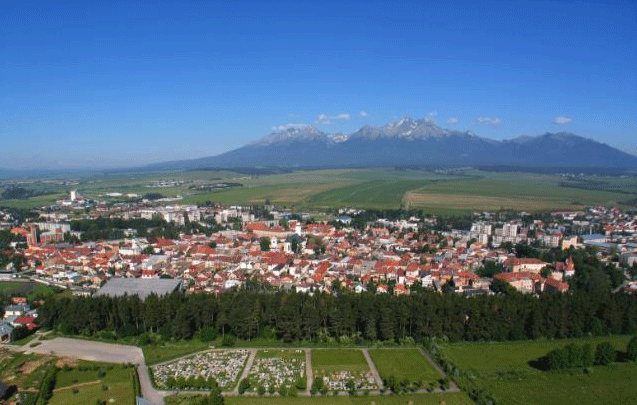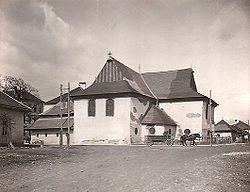
Wooden articular church in Kežmarok
Encyclopedia


Articular church
Articular churches are wooden churches for Evangelical congregations erected under the terms of the Congress of Sopron of 1681. At this congress, summoned by the Habsburg Emperor Leopold I, permission was for the first time granted for followers of the Augsburg and Calvinist confessions to erect...
in Kežmarok is a wooden church in Kežmarok
Kežmarok
Kežmarok is a town in the Spiš region of eastern Slovakia , on the Poprad River.-History:...
, Slovakia
Slovakia
The Slovak Republic is a landlocked state in Central Europe. It has a population of over five million and an area of about . Slovakia is bordered by the Czech Republic and Austria to the west, Poland to the north, Ukraine to the east and Hungary to the south...
. The local Lutherans
Lutheranism
Lutheranism is a major branch of Western Christianity that identifies with the theology of Martin Luther, a German reformer. Luther's efforts to reform the theology and practice of the church launched the Protestant Reformation...
built it during a period of religious persecution, when they were allowed to erect only wooden churches. That is why even nails were made exclusively of wood. The construction was financially supported by Protestants from various countries, including Sweden
Sweden
Sweden , officially the Kingdom of Sweden , is a Nordic country on the Scandinavian Peninsula in Northern Europe. Sweden borders with Norway and Finland and is connected to Denmark by a bridge-tunnel across the Öresund....
and Denmark
Denmark
Denmark is a Scandinavian country in Northern Europe. The countries of Denmark and Greenland, as well as the Faroe Islands, constitute the Kingdom of Denmark . It is the southernmost of the Nordic countries, southwest of Sweden and south of Norway, and bordered to the south by Germany. Denmark...
.
The only stone part of the church is its sacristy
Sacristy
A sacristy is a room for keeping vestments and other church furnishings, sacred vessels, and parish records.The sacristy is usually located inside the church, but in some cases it is an annex or separate building...
, originally built in 1593 as a pub outside the city walls. In the 17th century, the Roman Catholic dynasty of Habsburgs persecuted Protestantism in the Habsburg Monarchy
Habsburg Monarchy
The Habsburg Monarchy covered the territories ruled by the junior Austrian branch of the House of Habsburg , and then by the successor House of Habsburg-Lorraine , between 1526 and 1867/1918. The Imperial capital was Vienna, except from 1583 to 1611, when it was moved to Prague...
, which included Slovakia at that time. The number of churches was limited to one in each free royal town, Kežmarok being one of them. The construction material had to be the cheapest possible (wood at that time) and a church had to be completed in 365 days. Furthermore, the site of a new Protestant church had to be chosen by a royal commission. In Kežmarok, a royal commission deliberately chose an ancient pub as a place of worship, in order to humiliate the local Protestant community. The pub was subsequently incorporated into a hastily constructed religious building as a sacristy.
The oldest parts are an epitaph
Epitaph
An epitaph is a short text honoring a deceased person, strictly speaking that is inscribed on their tombstone or plaque, but also used figuratively. Some are specified by the dead person beforehand, others chosen by those responsible for the burial...
from 1688 and a Renaissance
Renaissance architecture
Renaissance architecture is the architecture of the period between the early 15th and early 17th centuries in different regions of Europe, demonstrating a conscious revival and development of certain elements of ancient Greek and Roman thought and material culture. Stylistically, Renaissance...
baptistery
Baptistery
In Christian architecture the baptistry or baptistery is the separate centrally-planned structure surrounding the baptismal font. The baptistry may be incorporated within the body of a church or cathedral and be provided with an altar as a chapel...
from 1690. They are the only remaining parts of the first church. The second wooden church, erected in the Baroque
Baroque
The Baroque is a period and the style that used exaggerated motion and clear, easily interpreted detail to produce drama, tension, exuberance, and grandeur in sculpture, painting, literature, dance, and music...
style in 1717, completely replaced the first building. It has the shape of an equal-armed Greek cross. The space can accommodate 1,541 worshipers. According to a legend, circular windows were made by Swedish sailors contributing to the construction. The organ, completed in 1729, is known for its perfect sound despite having only wooden pipes.
The church has been protected by the state as an important historical monument since 1892. In 1985, the Slovak parliament proclaimed it a National Historical Monument. An expensive reconstruction followed in the 1990s.
The church is one of only five Lutheran wooden churches remaining in Slovakia. The others are situated in Hronsek
Hronsek
Hronsek is a village and municipality of the Banská Bystrica District in the Banská Bystrica Region of Slovakia.-History:In historical records, the village was first mentioned in 1500, and it has changed its name many times during its History: Hronsek is a village and municipality of the Banská...
, Istebné
Istebné
Istebné is a village and municipality in Dolný Kubín District in the Zilina Region of northern Slovakia....
, Leštiny
Leštiny
Leštiny is a village and municipality in Dolný Kubín District in the Žilina Region of northern Slovakia.-Geography:The municipality lies at an altitude of 586 metres and covers an area of 6.939 km². It has a population of about 225 people....
, and Svätý Kríž near Liptovská Mara
Liptovská Mara
Liptovská Mara is a reservoir in northern Slovakia, on the Váh river near Liptovský Mikuláš, in the Liptov region. The dam is named after one of the inundated villages....
.

